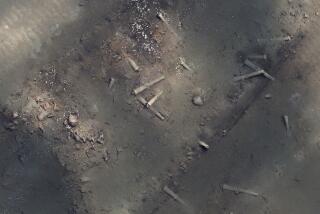Tiny Submarine in Big Demand by Archeologists
- Share via
UNDER THE AEGEAN SEA — The turquoise foam envelops the submersible as it hits the sea. Then it dips slightly and dives--moving gracefully like the mythical sea nymph that shares its name.
Archeologists who have peered through the sub’s glass-bubble nose look upon the sea floor with the same excitement as their predecessors surveyed the Greek landscape a century ago: anticipating great finds and new clues about ancient civilizations.
The tiny sub Thetis, named after Achilles’ mother and the daughter of the sea deity Nereus, is the centerpiece of big hopes for breakthroughs in the difficult field of underwater archeology.
A handful of antiquity and marine specialists have dreams of turning the clear Greek seas into a laboratory for underwater archeology, which is attracting more attention as marine technology improves. Researchers in places as varied as Egypt, the Caribbean and Kenya’s Indian Ocean coast have engaged in underwater probes for wrecks, artifacts and sunken ports.
Manned submarines have visited the hulk of the Titanic in the north Atlantic. In the Mediterranean, remote-controlled subs have sent back images of wrecks of ancient Greek and Phoenician trading vessels well preserved by the cold and oxygen-poor depths.
Some Greek officials are even contemplating breaking a long-standing rule by opening selected sites to tourist dives.
“With the Thetis we can reach, without fear, archeological areas at depths beyond diving. We can now record shipwrecks. We can photograph them . . . and we can even do experimental trial research or excavations,” said Katerina Delaporta, the archeologist in charge of maritime antiquities for the culture ministry.
But for the moment, archeologists have trouble getting their hands on the French-built sub--one of only two in operation in the world. The sub’s support ship is often booked doing other marine research.
Plans call for the purchase of a second ship capable of handling the Thetis, which would free the sub to take part in archeological missions around the Greek sea bed--a treasure trove of sunken vessels and cargo.
So far, the archeologists have used the Thetis just once since it was purchased last year. But it quickly paid off: finding an 18th-century shipwreck and thousands of plates off the island of Nissirio.
The $1.9-million sub, although smaller than a compact car, can carry two people to a depth of about 2,013 feet. It has enough battery power for at least eight hours of work, but it holds enough oxygen and food to sustain its crew for 72 hours in an emergency.
The Thetis is equipped with an arm to move objects and sonar in case visibility is low. It also has high-powered lights that help with filming and photography. Its sister ship, Remora, is located in France.
“It can do anything,” said Costas Thoctarides, Thetis’ chief pilot and one of a team of three divers employed by the National Center for Marine Research to take care of the sub.
Inside the spherical cabin, an observer gets close to a 360-degree view of the sea. But the heat can be stifling. There is no air conditioning once the capsule is closed, but divers pump cold air into the craft before they get in. It usually gets 18 degrees hotter inside Thetis than in the surrounding sea. In the summer, the Aegean can still be about 68 degrees even deep below the surface.
“The temperature goes up because of the material. It is very good for visibility, but it pulls heat,” Thoctarides said.
Besides searching for new finds, archeologists believe the sub can identify underwater sites that could be in danger from antiquity poachers.
The 2,500-year-old Acropolis in Athens has about 1,000 guards, Delaporta noted. But at the moment, there is little way to enforce laws that bar divers from most Greek waters without special permits.
“Shipwrecks or sunken towns are much harder to guard. . . . The diver thinks underwater belongs to them. At shipwrecks that are not so deep, nothing is left of them,” Delaporta said.
But unspoiled--and possibly new--discoveries could offer a new frontier for tourism in a country seeking to shed its image as a backpackers’ mecca and attract big-spending visitors.
Delaporta said she was thinking about creating an underwater archeological park around the two 2,000-year-old shipwrecks off the western Peloponnese near Methoni, about 150 miles southwest of Athens. The culture ministry has not yet decided what will happen with the site.
“But it cannot be guarded 100% . . . because at these kinds of shipwrecks . . . there are sarcophagi which weigh tons. [Poachers] tried to break the sarcophagus and its covering and steal it,” Delaporta said.
George Chronis, vice president of the marine research agency, said the Thetis could also attach to a camera to transmit videos of shipwrecks to audiences on ships or on land.
“There are a lot of plans. There is a lot of imagination. . . . It needs to be planned and funded,” Chronis said.
More to Read
Sign up for Essential California
The most important California stories and recommendations in your inbox every morning.
You may occasionally receive promotional content from the Los Angeles Times.













